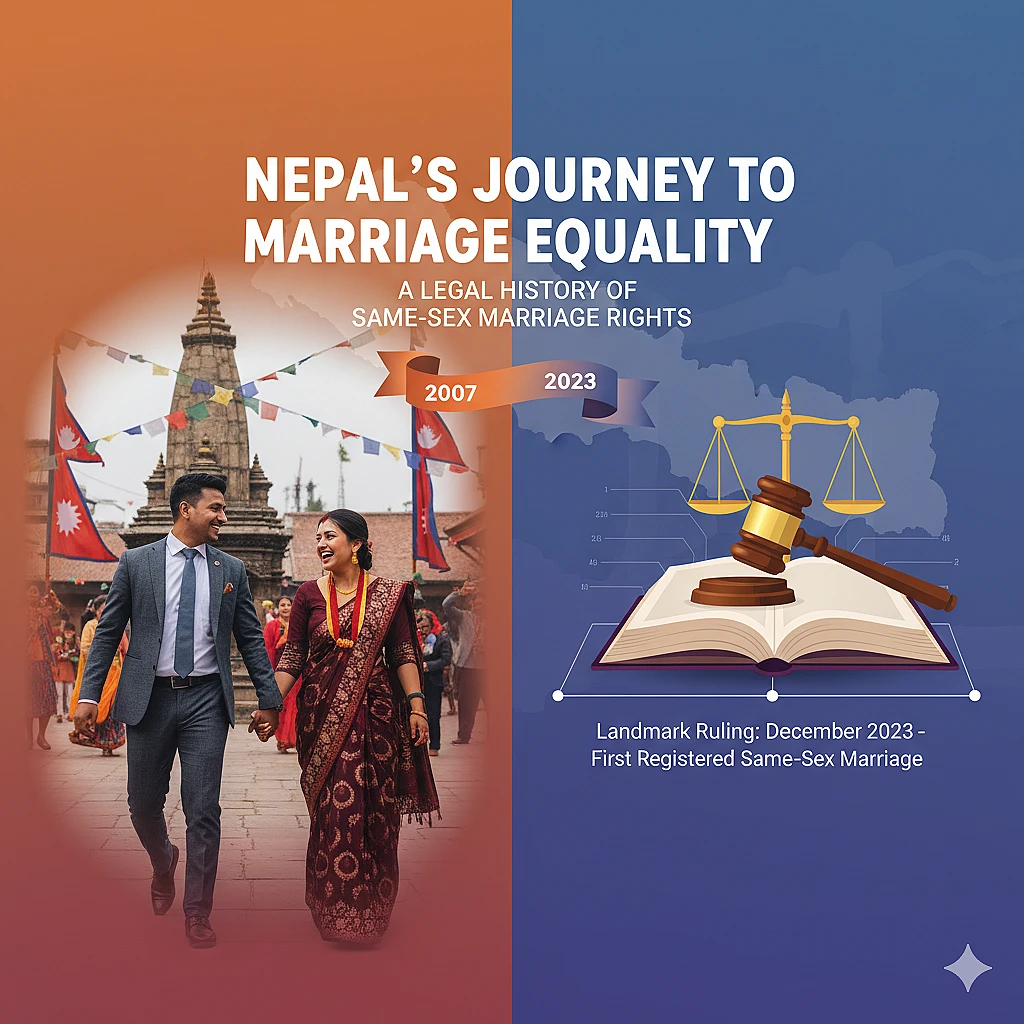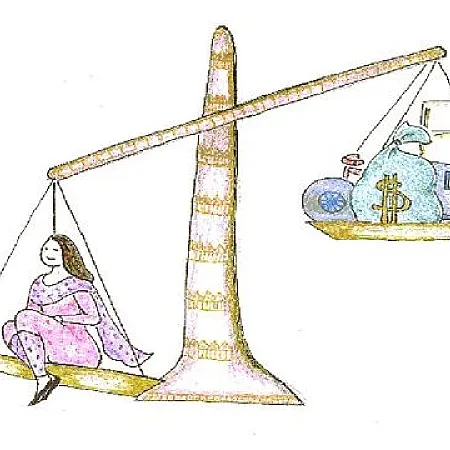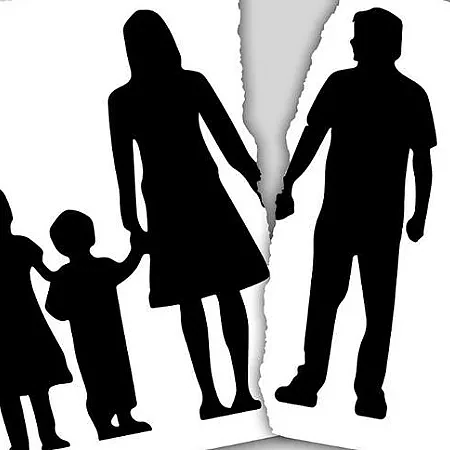Introduction: Nepal's Progressive Stance on LGBTQ+ Rights
Nepal has emerged as a beacon of hope for LGBTQ+ rights in South Asia, establishing itself as one of the most progressive nations in the region when it comes to recognizing and protecting the rights of sexual and gender minorities. The Himalayan nation's legal evolution regarding same-sex marriage represents a remarkable journey from judicial activism to constitutional recognition, culminating in provisional marriage equality that has positioned Nepal as the second country in Asia to provide legal recognition of marriage to LGBTQ+ couples.
This comprehensive exploration of same-sex marriage Nepal traces the legal milestones, landmark court decisions, and constitutional provisions that have shaped the current landscape of LGBTQ rights Nepal. From the groundbreaking 2007 Supreme Court ruling to the recent developments in Nepal marriage equality, we examine how judicial interpretations, constitutional reforms, and persistent advocacy have transformed the legal framework for same-sex relationships in Nepal.
The Foundation: 2007 Landmark Supreme Court Decision
Sunil Babu Pant and Others v. Nepal Government (2007)
The modern legal journey for same-sex marriage Nepal began with a historic Supreme Court case that would reshape the nation's approach to LGBTQ+ rights. On December 21, 2007, Nepal's Supreme Court delivered a groundbreaking judgment in Sunil Babu Pant and Others v. Nepal Government, a case filed by Mr. Sunil Babu Pant of the Blue Diamond Society and other LGBTQ+ advocacy organizations.
This landmark Nepal case law represented the first time a South Asian court had comprehensively addressed the rights of lesbian, gay, bisexual, transsexual, and intersex (LGBTI) people. The petitioners sought legal recognition of their gender identities based on self-identification and recognition of their relationships according to their sexual orientation.
The Supreme Court's ruling was revolutionary for several reasons:
-
Recognition of Human Rights: The Court acknowledged that homosexuals and third-gender people are not mentally ill or sexually perverted, establishing that their rights deserve protection under the constitution and international human rights instruments.
-
Right to Privacy: The judgment established that the right to privacy applies equally to LGBTQ+ individuals, stating that "no one has the right to question how two adults perform sexual intercourse and whether this intercourse is natural or unnatural."
-
Self-Determination: The Court recognized that "selection of sexual partner or fixing of marital relation is a matter falling entirely within the ambit of the right to self-determination."
-
Three Direct Orders: The Supreme Court issued three specific directives to the government:
- Audit all laws and eliminate those discriminating against LGBT people
- Form a committee to study same-sex marriage legislation in other countries
- Legally recognize a "third gender" category based on individuals' self-identification
This decision laid the groundwork for future LGBTQ rights Nepal developments and established Nepal as a pioneer in South Asia for recognizing sexual orientation and gender identity as protected categories under human rights law.
Constitutional Recognition: The 2015 Constitution
Article 18 and Gender and Sexual Minorities
Nepal's journey toward Nepal marriage equality took a significant leap forward with the promulgation of the new Constitution on September 20, 2015. The constitution-making process, which spanned several years and multiple constituent assemblies, resulted in Nepal becoming only the 10th country worldwide to enshrine specific protections for LGBTQ+ people in its national charter.
Article 18 of the 2015 Constitution stands as a cornerstone for LGBTQ rights Nepal, explicitly prohibiting discrimination based on gender and sexual orientation. The constitutional provision lists "gender and sexual minorities" (Nepali: लैङ्गिक तथा यौनिक अल्पसङ्ख्यक, laiṅgik tathā yaunik alpasaṅkhyak) among recognized and protected disadvantaged groups.
The inclusion of this language was the result of strategic advocacy by Sunil Pant, who had become Asia's first openly gay federal legislator as a member of the Constituent Assembly. Pant, serving on the committee drafting the fundamental rights chapter, successfully advocated for the insertion of "sexual and gender minorities" in social protection provisions and "sexual orientation" in non-discrimination clauses. In a masterful political move, he suggested changing the order to "gender and sexual minorities," which was met with applause from committee members and became the adopted language.
Constitutional Impact on Same-Sex Marriage Rights
While the 2015 Constitution marked a historic advancement for LGBTQ rights Nepal, it did not explicitly address same-sex marriage. This omission would create a legal tension that would play out in subsequent years, as constitutional protections for gender and sexual minorities conflicted with statutory law that maintained traditional definitions of marriage.
The constitution's silence on same-sex marriage reflected the complex political landscape of Nepal, which was still recovering from a decade-long civil war and navigating profound social and political transformations. However, the constitutional recognition of gender and sexual minorities provided a powerful legal foundation upon which future same-sex marriage Nepal advocates could build their case for full marriage equality.
Legal Setbacks: The 2018 National Code
Conflict Between Constitutional Protections and Statutory Law
Despite the progressive constitutional framework, the momentum for Nepal marriage equality faced a significant setback with the enactment of the National Code of Nepal in August 2018. This comprehensive legislation explicitly defined marriage as "when a man and a woman accept each other as husband and wife," directly contradicting the spirit of constitutional protections for gender and sexual minorities.
The National Code's restrictive marriage definition created a legal paradox: while the Constitution protected gender and sexual minorities from discrimination, the country's primary civil legislation limited marriage recognition to heterosexual couples. This contradiction would become the focal point of future legal challenges and underscored the need for judicial intervention to resolve the conflict between constitutional principles and statutory limitations.
Government Inaction on Same-Sex Marriage Recommendations
The path to same-sex marriage Nepal was further complicated by government inaction following the Supreme Court's 2007 directive. The committee formed to study same-sex marriage legislation submitted its report to the government in February 2015, effectively recommending the legalization of same-sex marriage. However, successive governments demonstrated little urgency in acting on these recommendations.
In January 2016, a government official indicated that the committee's recommendations were "under consultation," but no substantive progress was made. The National Human Rights Commission repeatedly called on the government to introduce a same-sex marriage bill, in February 2016 and again in July 2020, but these appeals went unheeded.
This legislative stagnation frustrated LGBTQ+ advocates, including Sunil Pant, who criticized the inaction in 2023: "The committee was formed, its members even went to Norway to study how same-sex married couples live. In 2015, the committee submitted their report to the government stating that Nepal should implement full marriage equality. Since then, the government and the parliament did nothing."
The 2023 Breakthrough: Pinky Gurung v. Nepal Government
Legal Challenge to Marriage Definition
The turning point for same-sex marriage Nepal came in 2023 with a new legal challenge to the constitutional validity of the restrictive marriage definition. Mitini Nepal, an LGBTQ+ advocacy group, filed a lawsuit challenging the constitutionality of the marriage definition in the Nepalese Civil Code.
On June 7, 2023, Pinky Gurung, president of the Blue Diamond Society, alongside eight other applicants, filed a public interest litigation seeking the legalization of same-sex marriage in Nepal. This case, Pinky Gurung v. Nepal Government, would prove to be the catalyst for significant progress toward Nepal marriage equality.
June 28, 2023 Supreme Court Directive
On June 28, 2023, Supreme Court Justice Til Prasad Shrestha issued a landmark directive in the Pinky Gurung case, ordering the government to take immediate action to recognize same-sex relationships. The directive represented a significant step forward in the evolution of LGBTQ rights Nepal and included several key provisions:
- Establishment of Separate Register: The Court directed the government to establish a "separate register" for "sexual minorities and non-traditional couples."
- Temporary Registration: The order mandated that same-sex couples be "temporarily registered" until a final verdict by the full bench of the Supreme Court is issued.
- Legal Recognition: The directive affirmed that prohibiting same-sex couples from marrying violates human rights and constitutes discrimination based on sexual orientation.
This Supreme Court order effectively made same-sex marriage de jure legal in Nepal, though without supporting legislation, marking Nepal as the second country in Asia to open marriage to same-sex couples after Taiwan.
Implementation and First Marriage Registration
Initial Resistance and Legal Challenges
Despite the Supreme Court's June 2023 directive, the path to implementing same-sex marriage Nepal was not without obstacles. The Kathmandu District Court initially denied a same-sex couple's application to marry on July 13, 2023. The couple appealed to the Patan High Court, but that court also rejected the appeal on October 6, 2023.
These early setbacks highlighted the resistance within parts of the judicial system to recognizing same-sex marriages, despite the Supreme Court's clear directive. However, LGBTQ+ advocates remained determined to secure the rights granted by the Supreme Court order.
Historic First Marriage Registration
The breakthrough came on November 29, 2023, when authorities in Dordi, a municipality in Lamjung District, legally recognized the marriage of Maya Gurung and Surendra Pandey. This marked the first time a same-sex marriage was registered in Nepal, representing a historic milestone in the nation's journey toward Nepal marriage equality.
The couple, who had fought for legal recognition of their relationship, finally received a temporary marriage certificate from their home district. This event was hailed as a victory for LGBTQ+ rights in Nepal and demonstrated that the Supreme Court's directive could be implemented at the local level.
Government Circular and Provisional Recognition
The progress continued into 2024, with the government taking steps to formalize the recognition of same-sex marriages. On April 24, 2024, the Home Affairs' National ID and Civil Registration Department issued a circular to local registration authorities, instructing them to temporarily enter same-sex marriages into a separate record.
This circular effectively established provisional recognition of same-sex marriage Nepal, though it came with important limitations. As confirmed by Mukesh Kumar Keshari, director of the National ID and Registration Department in May 2025, temporary certificates do not grant same-sex couples the full rights and benefits of marriage.
Current Status and Challenges
Legal Recognition Without Full Rights
As of 2025, same-sex marriage Nepal exists in a state of provisional recognition. While same-sex couples can register their marriages temporarily, they face significant limitations:
- Limited Rights: Temporary marriage certificates do not grant same-sex couples the full rights and benefits of marriage, including inheritance, tax benefits, and spousal protections.
- Administrative Barriers: Local offices still use gendered forms on marriage certificates, forcing same-sex couples to identify as "bride" and "groom" roles that don't reflect their identities.
- Procedural Challenges: The registration process for same-sex couples is longer and more expensive than for opposite-sex couples, often requiring legal assistance.
- Data Gaps: The Department of National ID and Civil Registration lacks official data on same-sex marriages, as temporary registrations are not entered into the nationwide online database.
Despite these challenges, at least seventeen marriages have been documented by local LGBTQ+ rights organizations as of 2025, with nine confirmed by local media reports.
Ongoing Legal Process
The full implementation of Nepal marriage equality awaits a final verdict from the full bench of the Supreme Court in the Pinky Gurung v. Nepal Government case. The Court has postponed the case more than eight times, citing "a shortage of constitutional bench judges."
The final verdict faces further uncertainty due to political turmoil in Nepal, including the burning of Supreme Court and Federal Parliament buildings during September 2025 turmoil, which forced many high-ranking officials to flee the country. These events have likely postponed the final verdict indefinitely.
Future Implications and Global Significance
Nepal's Role in South Asian LGBTQ+ Rights
Nepal's journey toward same-sex marriage Nepal holds significant implications for LGBTQ+ rights across South Asia and globally. As the first South Asian country to recognize LGBTQ+ rights constitutionally and the second in Asia to provide legal recognition of same-sex marriages, Nepal has established itself as a regional leader in LGBTQ+ equality.
The nation's legal evolution demonstrates that judicial activism, combined with constitutional reform and persistent advocacy, can overcome traditional social and legal barriers to LGBTQ+ rights. Nepal's experience provides valuable lessons for other countries in the region and beyond that are grappling with similar issues.
The Path Forward
The future of LGBTQ rights Nepal depends on several key developments:
- Final Supreme Court Verdict: A definitive ruling from the full bench of the Supreme Court could establish permanent marriage equality and resolve the current legal ambiguities.
- Legislative Action: Passage of comprehensive marriage equality legislation by the Federal Parliament would provide the statutory framework needed to fully implement same-sex marriage rights.
- Administrative Reform: Changes to marriage registration systems and forms would eliminate current barriers faced by same-sex couples.
- Public Education: Continued efforts to build public understanding and acceptance of LGBTQ+ relationships will be crucial for sustainable social change.
Conclusion: A Model of Progressive Legal Evolution
Nepal's journey toward marriage equality represents a remarkable example of how legal systems can evolve to recognize and protect the rights of sexual and gender minorities. From the groundbreaking 2007 Supreme Court decision in Sunil Babu Pant and Others v. Nepal Government to the provisional recognition established in 2024, Nepal has demonstrated that judicial courage, constitutional reform, and persistent advocacy can transform legal landscapes.
The story of same-sex marriage Nepal offers hope and inspiration to LGBTQ+ communities worldwide, particularly in regions where traditional values and legal systems have been slow to recognize diverse relationships and identities. While challenges remain in achieving full marriage equality, Nepal has established itself as a pioneer in South Asia, proving that progressive legal change is possible even in culturally conservative societies.
As Nepal continues its journey toward full implementation of marriage equality, the nation's experience will undoubtedly serve as a valuable reference for other countries grappling with similar questions of love, equality, and human rights. The evolution of LGBTQ rights Nepal stands as a testament to the power of legal advocacy, constitutional protection, and the enduring human quest for dignity and equality under the law.




